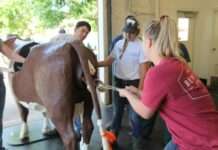As reported in High Plains Journal. The Federal Communications Commission announced Oct. 20 that it is ready to authorize $554,150,641 in its third round of funding for new broadband deployments through the Rural Digital Opportunity Fund. Together with two prior funding wave announcements, the commission has now announced over $1 billion in funding to winning bidders for new deployments.
The announcement came just one week before a report funded by the United Soybean Board laid out a series of recommendations on how to deploy broadband in rural areas.
The FCC has been examining the filing documents of the bidders since last December, when the funding was originally announced and bids invited. In this wave of funding, 11 broadband providers will bring fiber-to-the-home gigabit broadband service to more than 180,000 locations in 19 states. The commission denied several waiver petitions by companies that did not diligently pursue their applications.
“This is good news for consumers waiting far too long for broadband in parts of the country that have yet to be served,” said Acting Chairwoman Jessica Rosenworcel. “Broadband is an essential service and during the pandemic we’ve seen just how critical it is for families, schools, hospitals, and businesses to have affordable internet access. Thanks to the hard work of our dedicated FCC staff who are carefully reviewing applications and working to clean up the Rural Digital Opportunity Fund, this program will build new broadband infrastructure in areas that truly need it.”
The 19 states slated for this round’s funding are Alabama, Arkansas, Georgia, Illinois, Indiana, Iowa, Kentucky, Maine, Michigan, Minnesota, Mississippi, Missouri, Nebraska, North Carolina, New Mexico, Ohio, South Carolina, Texas and Wisconsin. Michigan and Georgia received the most funding in this wave, $188 million and $149 million, respectively. The commission continues close review of the applications of other winning bidders that were previously announced to ensure they meet the program’s technical, financial and legal requirements.
The FCC also continued to work to ensure that funding only supports providers that comply with program requirements. The FCC denied LTD Broadband’s petition seeking waiver of the deadline to be designated as an eligible telecommunications carrier in Iowa, Nebraska, and North Dakota, and denied NW Fiber’s petition seeking waiver of the deadline for submitting a post-auction long form application.
These efforts continue the agency’s work to clean up the program to ensure that funding goes to unserved areas that need broadband.
As part of that clean-up process, the commission has taken a number of actions, including:
• Sending letters to 197 applicants concerning areas where there was evidence of existing service or questions of waste. Bidders have already chosen not to pursue support in 5,094 census blocks in response to the commission’s letters.
• Denying waivers for winning bidders that have not made appropriate efforts to secure state approvals or prosecute their applications. These bidders would have otherwise received more than $344 million.
• Publishing a list of areas where providers had defaulted, thereby making those places available for other broadband funding opportunities.
• Conducting an exhaustive technical, financial, and legal review of all winning bidders.
Broadband report funded by soybean farmers
The FCC announcement came one week before the release of a report October 27, commissioned by the United Soybean Board and conducted by the Benton Institute for Broadband and Society. The report, titled The Future of American Farming: Broadband Solutions for the Farm Office, Field, and Community, demonstrates that providing U.S. farmers and ranchers with access to fast, affordable and reliable broadband will increase sustainability, allow for more reliable and efficient food production and strengthen rural communities.
“Data is the most valuable tool in our farm’s toolbox. Without a reliable connection to the internet, data collection and its subsequent use is severely limited,” said Meagan Kaiser, USB treasurer, soil scientist and Missouri farmer. “Data gives us the ability to identify plant nutrient requirements and target those nutrients only where they are needed, which leads to increased yields without expanding acreage. It all begins with connectivity.”
The report, based on extensive interviews with farmers, rural internet service providers, equipment manufacturers, and agricultural leaders and experts, lays out 15 actionable recommendations for deliver high-speed internet that farmers and rural communities need. Among the recommendations:
• Establish future-proof standards. To meet the growing demand among farmers for both upstream and downstream speeds, networks must be capable of 100/100 Mbps service.
• Adopt high-performance standards. Performance standards for upload speeds and latency should reflect the changing needs of the farmers for precision agriculture.
• Encourage deep fiber build-out. Fiber build-out in rural America, even if not directly to the farm, will be needed to support capable wireless connections for higher-bandwidth applications in the field.
• Address gaps in mapping on farmland. Broadband maps should include mobile coverage on agricultural lands. The underlying data that informs these maps must be available to the public.
• Address gaps in mapping on farmland. Broadband maps should include mobile coverage on agricultural lands. The underlying data that informs these maps must be available to the public.
• Support equity digital programs at the state and local levels. Digital equity programs can work with communities to help people make full use of broadband connections.
“To many farmers, sustainability incorporates the economic, environmental and social impacts of agriculture—a triple bottom line,” said Jordan Arnold, research associate for the Benton Institute for Broadband & Society and the report’s author. “Now it’s time to deploy the broadband networks and adoption strategies they need.”
“The recommendations are a direct response to the problems revealed in a 2019 rural broadband study from USB. This initial study showed 60% of U.S. farmers and ranchers do not believe they have adequate internet connectivity to run their businesses, and that plans to incorporate data into day-to-day decisions are often thwarted by slow internet speeds, high costs and unreliable service.”




